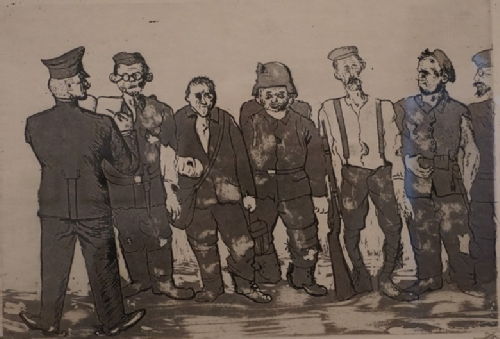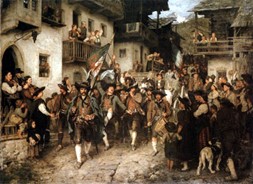All entries for Tuesday 04 October 2022
October 04, 2022
‘Homecoming’ after war: Comparative and interdisciplinary perspectives
Writing about web page https://warwick.ac.uk/fac/arts/hrc/confs/homecoming/
In his first blog Niels Boender discusses the Vision for the Conference: Mediations of the theme of ‘homecoming’
Central to our vision of this conference is the nebulous, historically contingent, and complex notion of ‘homecoming’ in post-war contexts. At a time of seamless global connectivity and slow deconstruction of the nuclear family, what constitutes the home, coded as safe and intimate, becomes increasingly questioned. This is far from unprecedented historically, never more so than at a time of war. In a physical sense, borders move, families are devastated, and people are displaced en masse. On a different plane, human subjectivities are entirely discombobulated by the experience of extreme hardship. New worlds are made not just on the battlefield, but in the moment the battlefield returns, the sphere previously understood as safe and domestic. With millions of the people on the move again due to the conflict in Ukraine, there is a growing importance in drawing together a wealth of scholarship on post-war homecoming and reconciliation to new conditions.
We are very glad to take this opportunity, provided by Warwick’s Humanities Research Centre, to organise a conference which can investigate this topic. The multidimensional nature of the homecoming experience provides great scope for interdisciplinary exploration. This approach must have a special concern for the representational elements of homecoming, enshrined most typically in art and literature. These approaches can be fruitfully combined with historical methodologies, unpicking the archive left by states and individuals experiencing post-conflict ruptures. We are especially excited to see the fruitful combination of older, historical schools, with newer ones, like the history of emotions and the study of public memorialisation. Similarly, there are no limits on the geographical or temporal scope of this study. A comparison of representations of homecoming in the Odyssey and Rambo: First Blood is not just possible, but entirely desired.
The stories people tell about homecoming, both as a historical source and a piece of art/literature, will form a significant component of this story. These come in the moment of homecoming itself, and as a crucial part of longer-term historical memory. The above painting, a product of German nationalist romanticism, depicts the return of Tyrolean fighters in 1809. This links the glorious return of Swiss fighters from the struggle against Napoleon, with the welding together of the German Empire in the 1870s. The moment of homecoming in particular is emphasised, signifying the sealing of a victory. By contrast, this image from prominent Weimar artist Otto Dix, depicting a very different homecoming in the aftermath of the First World War. This is of course the defining return after war, the one that led to genocidal campaign in the Baltic, the militarism of the Freikorps, and the paramilitary street battles which aided the rise of the Nazi Party. In these two images divided by less than half a century, two very different representations of homecoming appear. This points to a rich area of further investigation which this conference hopes to invite.
Our research as hosts, coming from two very diverse geographic and disciplinary spheres, exemplifies the precise interdisciplinary and comparative perspective we are trying to evoke. For example, my research in totality concerns the legacies of the Mau Mau Uprising in late colonial Kenya. However, a central and thus far disregarded moment in the study of the anti-colonial insurgency is the return of Mau Mau fighters from British-built detention camps in the latter years of the insurgency. These moments, ubiquitous in memoirs and oral recollections of the Uprising, tend to form a central dramatic moment in the working-out of future trajectories. Moreover, managing homecomings was an important part of the counterinsurgency effort of the colonial state. A future blog will explore this process in more detail.
Altogether, the conference will hope to place stories like the ones briefly cited above in conversation. The eventual desire is the production of an edited collection (with Routledge) that will significantly move forward the scholarship on this topic, and feed into a wider discussion of the post-war within the Humanities to rival the growing field of Peace Studies within the Social Sciences. While these hopes are ambitious, we hope that bringing together senior academics and early career researchers across various disciplines can achieve this goal.
Heimkehr der Sieger (Return home of the victors)(1874) by Franz Defregger (1835-1921).
Held at the Alte Nationalgalerie, Berlin.
Courtesy of Wikimedia Commons:
https://commons.wikimedia.org/wiki/File:Franz_von_Defregger_Heimkehrender_Tiroler_Landsturm.jpg

Appell de Zurückgekehrten (Roll Call of Returning Troops) (1924) by Otto Dix (1891-1969).
Held at the Museum of Modern Art.
Courtesy of user Spelio on Flickr: https://www.flickr.com/photos/spelio/28388017797

 Sue Rae
Sue Rae

 Please wait - comments are loading
Please wait - comments are loading
 Loading…
Loading…